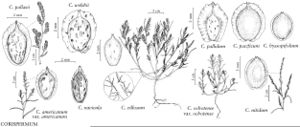Difference between revisions of "Corispermum nitidum"
Oestr. Fl. ed. 2, 1: 7. 1814.
imported>Volume Importer |
imported>Volume Importer |
||
| Line 54: | Line 54: | ||
|publication year=1814 | |publication year=1814 | ||
|special status=Introduced;Illustrated | |special status=Introduced;Illustrated | ||
| − | |source xml=https:// | + | |source xml=https://bitbucket.org/aafc-mbb/fna-data-curation/src/2e0870ddd59836b60bcf96646a41e87ea5a5943a/coarse_grained_fna_xml/V4/V4_621.xml |
|genus=Corispermum | |genus=Corispermum | ||
|species=Corispermum nitidum | |species=Corispermum nitidum | ||
Latest revision as of 21:59, 5 November 2020
Plants branched from base (rarely slightly above base), 10–55(–70) cm, glabrous or sparsely covered with dendroid or stellate hairs (then often becoming glabrous). Leaf blades narrowly linear or filiform (rarely linear), usually convolute or folded (especially in mature and/or dry plants), rarely plane (when young), 2–4(–5) × 0.1–0.2 cm. Inflorescences lax, usually interrupted from base to apex, rarely slightly condensed (only at apex when immature), narrowly linear or linear. Bracts narrowly ovate-lanceolate, lanceolate, linear-lanceolate, or linear, 0.5–1.5(–2) × 0.1–0.3(–0.4) cm, (most bracts within inflorescence rather uniform, usually narrower than mature fruits). Perianth segments 1–3. Fruits straw colored (yellowish brown), light brown, deep olive green, occasionally tinged with red, without spots and warts, convex abaxially, plane or slightly concave adaxially, obovate or broadly elliptic, often broadest near middle (rarely slightly above), 2.3–3.3(–3.5) × (1.8–)2–2.8 mm, shiny; wing translucent, thin, usually 0.1–0.3 mm wide, margins entire, apex rounded.
Phenology: Flowering late summer–early fall.
Habitat: Sand dunes, sandy and gravely shores, waste places
Distribution
Introduced; Supposedly se Europe (with small extension into w Asia).
Discussion
Specimens of Corispermum nitidum superficially similar to, or almost indistinguishable from, European C. nitidum in their habit (especially when immature) are fairly common in North American collections. Judging from their fruit morphology, they mostly belong to C. americanum (or probably to introgressive hybrids between the introduced C. nitidum and native C. americanum). I have not seen any unquestionably reliable specimens of C. nitidum sensu stricto from North America. More detailed comparative experimental and field studies are needed in order to clarify the complicated taxonomy of the group in North America.
Selected References
None.
